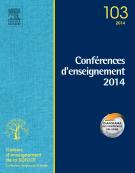Fractures récentes et anciennes de la diaphyse humérale de l’adulte : Recent and late humeral shaft fracture - 11/03/15
| pagine | 11 |
| Iconografia | 5 |
| Video | 0 |
| Altro | 0 |
Résumé |
Les fractures de la diaphyse humérale représentent 5% de toutes les fractures.
De nombreuses fractures sont encore traitées orthopédiquement de nos jours (méthode de Sarmiento ou plâtre pendant), la consolidation étant obtenue dans un délai de 10 semaines dans plus de 94% des fractures. Un cal vicieux inférieur à 30° de varus ou de valgus et inférieur à 20° de recurvatum ou de flessum est tolérable esthétiquement ou fonctionnellement. Le monotraumatisé est le candidat idéal pour un tel traitement.
L’ostéosynthèse par plaque permet d’obtenir la consolidation en 11 à 19 semaines. Les complications sont la pseudarthrose (2,8 à 21% selon les séries), la paralysie radiale secondaire (6,5 à 12%) et l’infection (0,8 à 2,4%).
L’ostéosynthèse par clou centro-médullaire antérograde ou rétrograde impose une connaissance de l’enclouage et de l’anatomie afin d’éviter les complications de cette technique. La consolidation est obtenue en 10 à 15 semaines, les complications étant la pseudarthrose (2 à 17,4%) et l’infection (0 à 4%); la paralysie radiale secondaire est plus rare (2,7 à 5%). Proche de l’enclouage, l’embrochage fasciculé de Hackethal est encore utilisé malgré son taux élevé de complications (pseudarthrose : 5 à 24%; migration des broches : 6 à 29%) du fait de ses avantages (faible coût et absence d’ancillaire spécifique). Il permet d’obtenir la consolidation en 8 à 9 semaines.
La conduite à tenir vis-à-vis de l’atteinte initiale du nerf radial est encore source de controverses. En cas de déplacement initial important, de fracture ouverte, de lésion vasculaire ou de traitement chirurgical, le consensus est formel : le nerf doit être exploré. Dans les autres cas, l’attitude est très variable.
Le traitement orthopédique est peu onéreux et son taux de complications est faible. Les traitements chirurgicaux sont de plus en plus pratiqués mais ils sont plus coûteux et sources de complications plus nombreuses.
Il testo completo di questo articolo è disponibile in PDF.Abstract |
Humeral shaft fractures represent 5% of the fractures.
Numerous fractures are orthopedically still treated nowadays (Sarmiento’s brace or hanging plaster). The consolidation is obtained in an average of 10 weeks in more than 94% of the fractures. A malunion lower than 30° of varus or valgus and lower than 20° of recurvatum or flessum is tolerated aesthetically or functionally. The monoinjured patient is the ideal candidate for such a treatment.
The synthesis by plate allows to obtain a consolidation in 11 to 19 weeks. The complications are the nonunion (2,8 to 21% according to the series), the secondary radial paralysis (6,5 to 12%) and the infection (0,8 to 2,4%).
The synthesis by anterograde or retrograde nail need a knowledge of the nailing and of the anatomy to avoid the pitfalls of this technique. The union is obtained in 10 to 15 weeks. The complications are the nonunion (2 to 17,4%) and the infection (0 to 4%), the secondary radial paralysis being less frequent (2,7 to 5%). Close to the nailing, the Hackethal stacked nailing is still used despite its number of complications (nonunion: 5 to 24%; pins migration: 6 to 29%) because of its advantages (low cost and no specific ancillary). The union is obtained in 8 to 9 weeks.
The best way in front of an immediate paralysis of the n. radialis is still source of controversies. In case of important initial displacement, of open fracture, of vascular complication or of surgical treatment, the consensus is formal: the nerve must be explored. Otherwise, the attitude remains very variable.
The orthopaedic treatment have a low cost with a low rate of complications rate to be put in balance with the surgical treatments, which are more up to date, but with a higher cost and more numerous complications.
Il testo completo di questo articolo è disponibile in PDF.Mots clés : Fracture de la diaphyse humérale, Anatomie de l’humérus, Paralysie radiale
Key words : Humeral shaft fracture, Humeral anatomy, Radial palsy
Mappa
© 2014 Elsevier Masson SAS. Tutti i diritti riservati.
Benvenuto su EM|consulte, il riferimento dei professionisti della salute.
L'accesso al testo integrale di questo articolo richiede un abbonamento o un acquisto all'unità.
Benvenuto su EM|consulte, il riferimento dei professionisti della salute.
L'accesso al testo integrale di questo articolo richiede un abbonamento.
Già abbonato a questo prodotto ?


